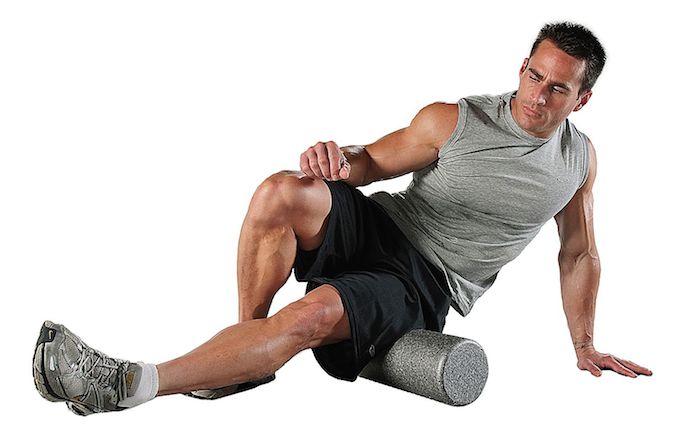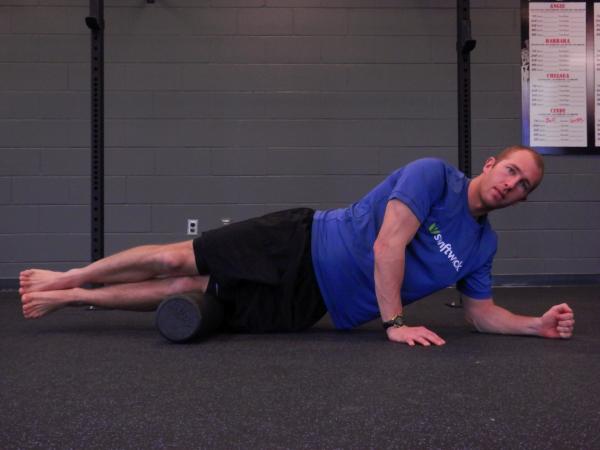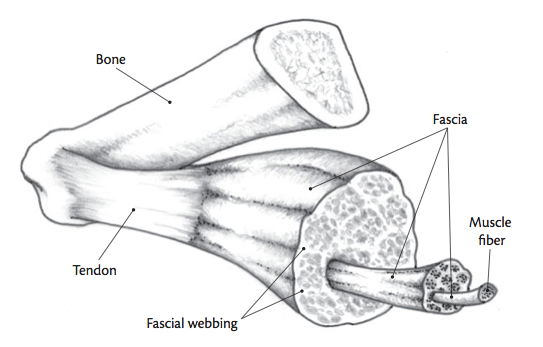What Is Foam Rolling And How Does It Work?

Foam rolling is a technique for self-myofascial release that has become very popular over the last few years. The technique is essentially taking a foam roller and rolling it under a muscle group until a tender area is found, then maintaining pressure on that area for 30-60 seconds. Even if you’ve never done foam rolling yourself, then you’ve probably seen people doing it at the gym. It looks like this:

Foam rolling helps to release muscle tightness, works out knots in your muscles, and can be extremely effective in curing all sorts of musculoskeletal pain.
In order to understand how foam rolling works, and why it’s so effective, you’ll need to have a basic understanding of muscle fascia.
An Introduction To Fascia
Like I mentioned, foam rolling is a type of myofascial release. But what does myofascial mean? The term myofascial refers to both muscle (myo) and fascia.
Fascia is a fibrous connective tissue that surrounds and envelopes nearly all the structures of the body, including muscles, blood vessels, nerves, organs, and bones. It’s composed primarily of water, collagen, elastin, and proteoglycans (you better know proteoglycans as the supplements chondroitin and glucosamine).
Skeletal muscle is made up of many bundles of individual muscle fibers held together by fascia. Not only are the full muscles themselves surrounded by fascia, but each individual muscle fiber is also surrounded by fascia. Look at the diagram below to see how fascia pervades the entire muscle:

Ming Chew, a well-known physical therapist who’s treated many major league sports stars, has a fantastic analogy in his book The Permanent Pain Cure that will help you better understand the role of fascia:
“Imagine that you can tap a grapefruit with a wand and make all the juice disappear. What’s left is the pulp and the flexible fibrous webbing that separates the sections. Both of these are the fascia. The webbing is like the fascia that separates one muscle from another. The pulp represents the fascia intertwined with muscle fibers and blood vessels.”
Fascia has a gelatinous texture and holds water like a sponge. In fact, 70% of fascia is made up of water, and the more water you consume, the more gelatinous your fascia will be. Healthy fascia is soft, hydrated, and flexible, and can take an incredible amount of pushing, pulling, and compression without being torn apart.
You can think of fascia as a web that connects our entire body, from the bottom of our feet to the top of our heads. This is a key point to understand. It explains why the source of pain is often not in the location where the pain is actually felt. For instance, you can have knee pain stemming from muscle adhesions in your neck and lower back. More on this later.
Bumps And Lumps In The Fascia
We’ve all had muscle knots before, areas of concentrated tightness in our neck, shoulders, etc. These knots are really bumps and lumps in the fascia – tightly contracted muscle tissue – also known as adhesions or trigger points. Adhesions are caused by overuse of the muscle, underuse of the muscle, bruises, wounds, poor posture, trauma from surgery, etc.
These adhesions cause the fascia to become tight, rigid, and stuck. They create restrictions in movement by disturbing the balance between muscles. Tight fascia also compresses the nerves and inhibits neural feedback, leading to additional muscle weakness and pain.
You probably have many more adhesions in your fascia than you realize. A knot in your neck or upper back may be very noticeable, but you likely have many smaller adhesions throughout your web of fascia from years of overuse, underuse, bad posture, etc.
When these adhesions are released and the fascia is able to function properly again, you’ll see an almost immediate improvement in mobility. And if you have any type of musculoskeletal pain, there’s a good chance that myofascial release is the answer you’ve been looking for. When people start to actively take care of their fascia, they often remark at how much younger their bodies feel.
There are several different techniques that help to restore optimal health to fascial tissue. One of these techniques is foam rolling, and it’s great because you can do it yourself!
Where Foam Rolling Comes In
By using various foam rolling techniques, you can apply precise pressure to your trigger points (adhesions) and cause them to release. Applying pressure to adhesions breaks up the scar tissue that keeps the fascia tight and stuck in a knot, restoring the tissue to its natural, supple state.
To foam roll properly, you want to apply a moderate amount of pressure to your tender areas using only the foam roller and your body weight. To find these areas, you slowly roll the foam roller over the muscle group you’re targeting, stopping when you find a tender spot. Pause for 30-60 seconds, relax as much as possible, and allow the roller to dig into the tender spot like a deep tissue masseur would. Yes, this is often painful, but the pain shouldn’t be unbearable.
You’ll find that the tight, tender areas you foam roll will slowly begin to release, and with this release there is a decrease in pain and tightness. Sometimes the knots will release fully in one session. Sometimes they will take multiple sessions, depending on the stubbornness of the knot.
I’ll be posting some great foam rolling routines for specific muscle groups that will help you get results with foam rolling. Stay tuned for these routines, along with other techniques I will introduce you to that help release tight, knotted fascia.